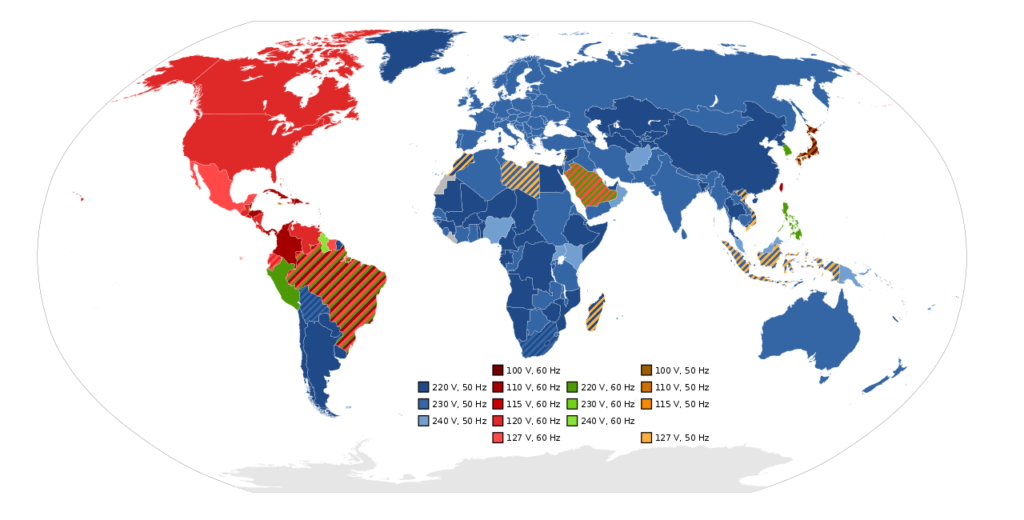
Each year there are millions of people who move overseas or decide to live abroad. Some make the move for business, others for retirement, and many do it for better living opportunities or simply to be with family. It's a growing trend with an estimated (and surprising) global rise of over 30% in 2012 alone. Making the decision to move to another country or continent is a big one and definitely requires its fair share of careful planning.
One very important factor that is often overlooked, ignored, or just completely forgotten about is taking your electronics. No, we're not talking about literally forgetting to take your electronics - we're talking about being able to use them once you get there.
If you're wondering "What?! Why wouldn't I be able to use my electronics once I get there?", than you need to keep reading.
Many parts of the globe, believe it or not, are not operating at your standard levels of voltage. It's true! Although most people are well aware of this minor yet important setback (especially those international travelers who've found out the hard way) or have heard of it at some previous point in their lifetime, it's easy to forget. Considering all of the planning, effort, and money that goes into making an international move, the last thing you'd want to forget or not be aware of is this:
North America, most of Central/South America, and The Caribbean have electricity services operating at a uniformed standard of 110 Volts. For the most part, and with the exception of Japan, everyone else is operating at a standard of 220 Volts. (For the record, to avoid confusion and for technical purposes only, the 110 and 220 are not exact voltages as 110 is considered to be anything between 110 and 127 volts, while 220 is considered to be anything between 220 and 240 volts)
So now you know. The next important question is "what does it mean and what can I do about it?"
First off, and most importantly, you should understand that if your electrical devices or appliances are made for a 110 volts that they will not work in a country where the standard is 220 volts. Secondly, you can easily identify what voltage your devices have been manufactured for by looking at the manufacturer's label.
The next step you should take is to find out what voltage standard the country you're heading to is operating on. This can be done with a simple internet search; seeing that you're reading this online, we already know that you have an internet connection. Excellent.
Once you've discovered which voltage your belongings use and which voltage is offered at your destination, the next step is deciding what electrical devices you'll be bringing with you. Keep in mind that the following options are available to you at this point
- Bring your electronic/electrical devices with you when you move and ensure their full functionality by purchasing a voltage converter
- Leave your electronics behind and purchase new ones upon reaching your destination
- Purchase multi-system electronics
Typically, you'll find that your decision is going to include a combination of the above.
Of course the smaller, more important and user-specific items such as computers, laptops, cell phones, and electric razors can be easily transported in luggage. Therefore, a
voltage converter is the best option as it's simple, allows you to keep your existing devices, and saves you from having to spend money on new purchases. Voltage converters (also known as voltage transformers) allow you to use your 110 volt device in a 220 volt environment, and vice-versa. The voltage converter plugs into the wall and you simply plug your devices into the converter itself. Simple, reliable, and cost effective.
Meanwhile, larger appliances such as washers and dryers are big and bulky and use excessive electricity. In this case, you're probably planning to purchase these products in your destination country. However, if you'd prefer to save money, you should purchase the
220 volt appliances locally beforehand as they are less costly than in a 220-standard destination. The situation is similar with multi-system electronics. Multi-system electronics hold the unique and convenient ability to operate in both the 110 volt and 220 volt environments. Televisions and home theater systems are the two most popular and commonly purchased multi-system electronic products.
Additionally, there's another unique product, this one being for those who take their movies seriously. Region Free DVD and Blu-Ray Players, also known as "code free" or "multi-region" players. These players can play DVD and Blu-Ray discs that have been encoded for use only in players sold within within that same region. The purposes behind the manufacture and encoding of region-specific discs are many:
- Price differences in different regions
- The ability to control different release dates for different countries
- Preventing the playability of certain materials for religious, cultural, or political purposes
If you're a movie fan, if you plan on bringing your collection with you, or if you simply enjoy the ability to purchase and watch a movie in your native language a
multi-region DVD player is exactly what you need. For Example, a multi-region DVD player will allow you to play DVD's which have been bought locally as well as those that have been purchased online from another country. Should you decide to live abroad or travel from country to country, a region-free player offers total convenience.
Last but not least, you should be aware that there are various styles of outlets that pose yet another obstacle. Different types of wall outlets/sockets mean that even if you have a converter, you might not be able to plug it in. Additionally, you may thing you are moving to a country with the same voltage standard but fail to realize that the plugs for your devices are not identical. Luckily, there are foreign voltage plug adapter kits, allowing you to easily plug in anywhere around the globe.
For more information on moving overseas with electronics, as well as a complete line of voltage converters, multi-system electronics, multi-region players and 220 volt appliances, visit
www.220-electronics.com where you can find helpful information and top quality products from specialists with over 30 years of experience in helping provide electronics to individuals and families who are relocating. If you are looking for additional resources in regards to international travel, please visit the
International Travel Information website for all the information you need to plan a successful and safe international trip.
 Voltages around the world.[/caption]
As a result of this distinction, some electronics will work without issue in certain countries while not functioning properly in others. Specifically, when appliances from 110 volt countries need to be used in 220 volt countries, a "Step-Up" voltage converter is needed. When appliances from 220 volt countries need to be used in 110 volt countries, a "Step-Down" converter is required.
[caption id="attachment_1610" align="aligncenter" width="231"]
Voltages around the world.[/caption]
As a result of this distinction, some electronics will work without issue in certain countries while not functioning properly in others. Specifically, when appliances from 110 volt countries need to be used in 220 volt countries, a "Step-Up" voltage converter is needed. When appliances from 220 volt countries need to be used in 110 volt countries, a "Step-Down" converter is required.
[caption id="attachment_1610" align="aligncenter" width="231"] Step-Up vs Step-Down, visualized.[/caption]
Step-Up vs Step-Down, visualized.[/caption]

 Each year there are millions of people who move overseas or decide to live abroad. Some make the move for business, others for retirement, and many do it for better living opportunities or simply to be with family. It's a growing trend with an estimated (and surprising) global rise of over 30% in 2012 alone. Making the decision to move to another country or continent is a big one and definitely requires its fair share of careful planning.
One very important factor that is often overlooked, ignored, or just completely forgotten about is taking your electronics. No, we're not talking about literally forgetting to take your electronics - we're talking about being able to use them once you get there.
If you're wondering "What?! Why wouldn't I be able to use my electronics once I get there?", than you need to keep reading.
Many parts of the globe, believe it or not, are not operating at your standard levels of voltage. It's true! Although most people are well aware of this minor yet important setback (especially those international travelers who've found out the hard way) or have heard of it at some previous point in their lifetime, it's easy to forget. Considering all of the planning, effort, and money that goes into making an international move, the last thing you'd want to forget or not be aware of is this:
North America, most of Central/South America, and The Caribbean have electricity services operating at a uniformed standard of 110 Volts. For the most part, and with the exception of Japan, everyone else is operating at a standard of 220 Volts. (For the record, to avoid confusion and for technical purposes only, the 110 and 220 are not exact voltages as 110 is considered to be anything between 110 and 127 volts, while 220 is considered to be anything between 220 and 240 volts)
So now you know. The next important question is "what does it mean and what can I do about it?"
First off, and most importantly, you should understand that if your electrical devices or appliances are made for a 110 volts that they will not work in a country where the standard is 220 volts. Secondly, you can easily identify what voltage your devices have been manufactured for by looking at the manufacturer's label.
The next step you should take is to find out what voltage standard the country you're heading to is operating on. This can be done with a simple internet search; seeing that you're reading this online, we already know that you have an internet connection. Excellent.
Once you've discovered which voltage your belongings use and which voltage is offered at your destination, the next step is deciding what electrical devices you'll be bringing with you. Keep in mind that the following options are available to you at this point
Each year there are millions of people who move overseas or decide to live abroad. Some make the move for business, others for retirement, and many do it for better living opportunities or simply to be with family. It's a growing trend with an estimated (and surprising) global rise of over 30% in 2012 alone. Making the decision to move to another country or continent is a big one and definitely requires its fair share of careful planning.
One very important factor that is often overlooked, ignored, or just completely forgotten about is taking your electronics. No, we're not talking about literally forgetting to take your electronics - we're talking about being able to use them once you get there.
If you're wondering "What?! Why wouldn't I be able to use my electronics once I get there?", than you need to keep reading.
Many parts of the globe, believe it or not, are not operating at your standard levels of voltage. It's true! Although most people are well aware of this minor yet important setback (especially those international travelers who've found out the hard way) or have heard of it at some previous point in their lifetime, it's easy to forget. Considering all of the planning, effort, and money that goes into making an international move, the last thing you'd want to forget or not be aware of is this:
North America, most of Central/South America, and The Caribbean have electricity services operating at a uniformed standard of 110 Volts. For the most part, and with the exception of Japan, everyone else is operating at a standard of 220 Volts. (For the record, to avoid confusion and for technical purposes only, the 110 and 220 are not exact voltages as 110 is considered to be anything between 110 and 127 volts, while 220 is considered to be anything between 220 and 240 volts)
So now you know. The next important question is "what does it mean and what can I do about it?"
First off, and most importantly, you should understand that if your electrical devices or appliances are made for a 110 volts that they will not work in a country where the standard is 220 volts. Secondly, you can easily identify what voltage your devices have been manufactured for by looking at the manufacturer's label.
The next step you should take is to find out what voltage standard the country you're heading to is operating on. This can be done with a simple internet search; seeing that you're reading this online, we already know that you have an internet connection. Excellent.
Once you've discovered which voltage your belongings use and which voltage is offered at your destination, the next step is deciding what electrical devices you'll be bringing with you. Keep in mind that the following options are available to you at this point


